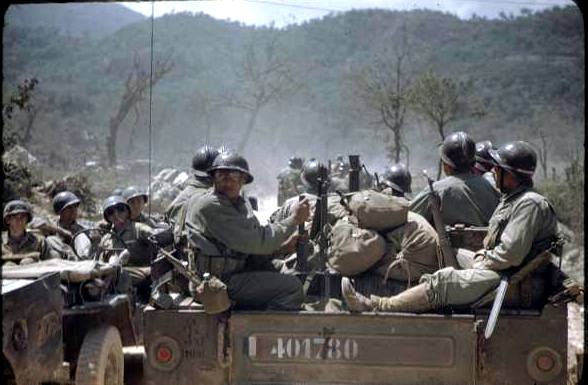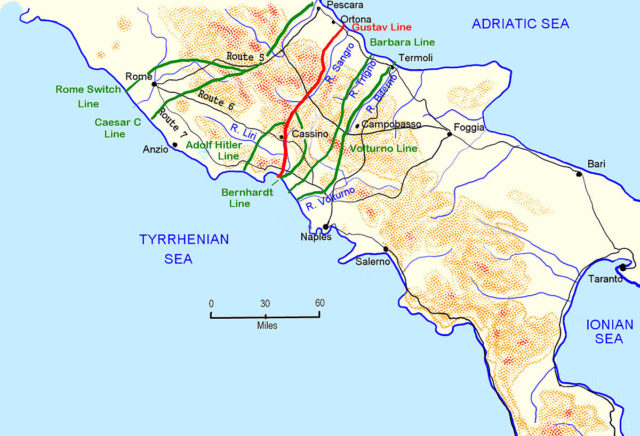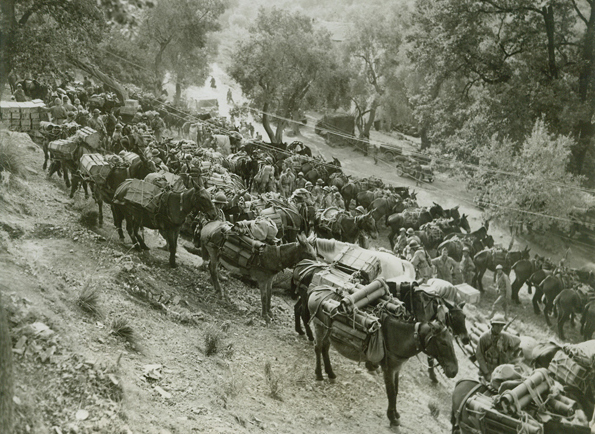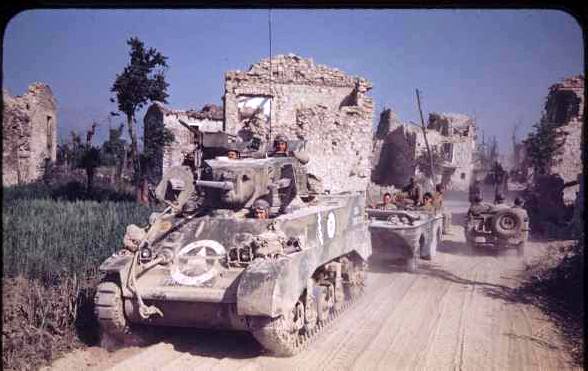War History Online presents this Guest Article from Pietro Giovanni Liuzzi
Italy, September 1943 – May 1944
Following the defenestration of Mussolini on July 25, 1943, the Germans started to believe in the worst: the landing of the Allied Forces in Italy. They, in fact, envisaged that a main landing could take place in the Gulf of Salerno, as it happened on September 9 with the Avalanche Operation.
In preparation for this, General Albert Kesselring, commander of C Army in Italy, ordered the setting up of a main defensive line to stop or delay the progressive advance of the Allied Forces: the Gustav Line, a system of defensive lines across the peninsula from the Tyrrhenian to the Adriatic Sea having Cassino as a strongpoint. He also ordered the set-up of another defensive line further North linking Massa and Carrara to Pesaro, situated on the opposite coastlines: the Gothic Line.
It was a decision of great strategic importance: the German Organisation Todt provided the Zwangsarbeiter (forced workers) abducted from the local population to set up a massive defensive line system, so fortified it took nine months and four offensives before the Allies could break through.
Initially, the workers spontaneously presented themselves to the Germans knowing the alternative would have been far worse: the lager. They were allowed to go back to their homes after work and to return to the sites next morning; later, as time went on, that concession was abolished for the urgent need to complete the pending works; only relatives were allowed to bring them food.

Shelters for personnel and ammunition, barracks, trenches, walkways connecting emplacements were built. Public and private buildings obstructing observation and firing sectors were demolished. Minefields were scattered along the defensive line as well as observation posts, nests of machine guns and every other conceivable apparatus. The Gustav Line absorbed a huge economic effort and manpower.
The Gustav Line was divided into five distinct lines: Volturno, Barbara, Bernhardt, Gustav and Hitler lines. The latter re-named Senger-Riegel because, if annihilated, the Fuhrer’s status would have been diminished.

The Allied landing began at 03.30 on September 9 on a front of 42 km. The Allies encountered great resistance by the German divisions who managed to open up a main loophole in the enemy settlement along the Sele River. For eleven hard days, the Allies were stuck in their positions. Thanks to the prolonged heavy naval artillery fire and continuous air raids the Allies managed to avoid the worst.
Great help in such circumstances was offered by the uprising of the Neapolitans men, women and children (the four days of Naples) from September 27 to the 30th. The German troops were forced to retreat not before destroying the harbor, water tanks, roads and bridges and raiding everything possible.
On October 12, the American Fifth Army reached the Volturno Line, crossed four days later after hard fighting. On November 2 the Allies were in front of the Barbara Line giving time for General Kesselring to complete the consolidation of the proper Gustav defensive line.
The Fifth American Army was deployed in the stretch from the Tyrrhenian Sea to Saint Elia, east of Cassino, and the VIII British Army from there to the Adriatic Sea.
In the course of three battles very little advantages in the advance had been made whilst the cost of human loss was very high. The weather was somewhat so rigid and rainy to be defined as “the worst in living memory conditions”. The armored vehicles had difficulty moving in hilly land crossed by rivers and streams in flood. Only hand to hand fighting allowed gains to some position that were soon recaptured by the enemy. Thousands of printed leaflets were launched by the Luftwaffe airplanes reporting an image of a snail moving slowly on to Italy. The note read “the road is long”.

The Germans tried to resist as much as possible to offer the main body of the retiring troops time enough to reach and man the second fortified defensive line North of Firenze: the Gothic Line.
Small mobile German units after an offensive action used to leave their positions for others at the rear where they could hit back from the spots occupied by the enemy knowing their precise topographic data.
The situation on the front was stalled. As an example: Santa Maria Infante. It is a small town next to the Gustav line. It was subject to seventeen attacks and counterattacks. It was razed to the ground and today it is as it was after the war: an open air museum to show to the world the ugliness of war.

Given the immobility of the front, after the third battle of Cassino with no success, the French General Alphonse Juin proposed to General Alexander to put in action the CEF, (Corp Expéditionnaire Français – Expeditionary French Corp). The proposal was accepted. The French contingent, landed in Naples, was composed of four divisions of about 99,000 men strong, composed by French – Moroccan – Algerian – Tunisian and Senegalese soldiers, equipped with 4,000 mules to transport all necessary equipment. The CEF was characterized by the presence of about 12,000 goumiers, Moroccans and Algerians specialized in mountain warfare. Organized in small groups (goum) under the command of a French officer, they were able to go where regular troops would not be able to.
Capable of a silent attack of the enemy, at night, they would eliminate whoever was on their path taking away mementos to display later. To them, it was entrusted the task of overcoming the Aurunci and head towards Cassino to allow allied troops the breaking of the Gustav line.
To be continued.
Pietro Giovanni Liuzzi, essayist
Colonel (Rtd.) Italian Army
Facebook
Photos provided by the author.
